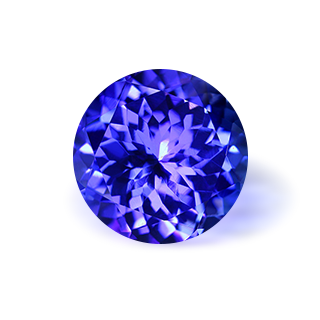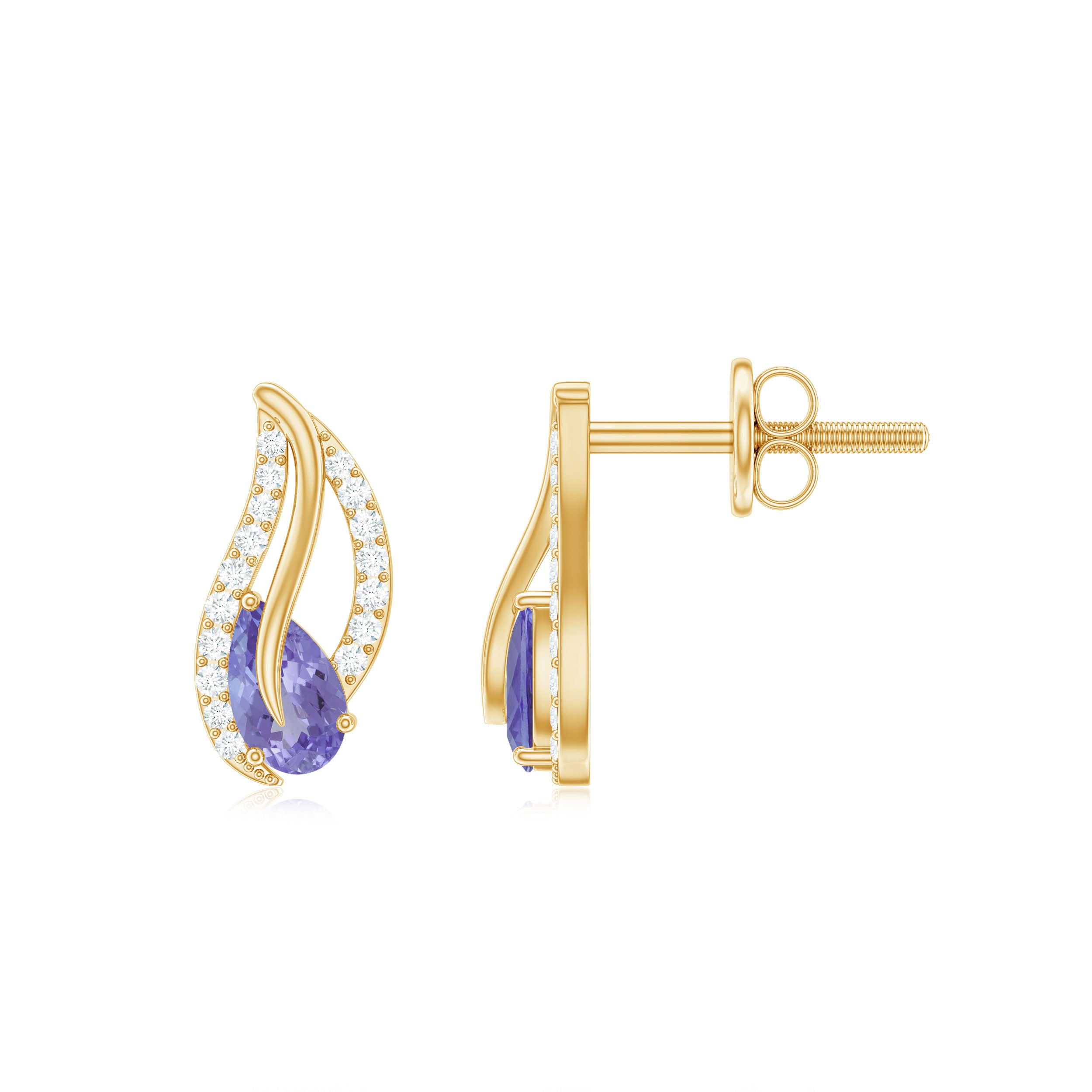All About Tanzanite: Types, Colors, Description, Origins & Details
Royal, rare and rich in bright blue is how we’d label Tanzanite. Aren’t you already a fan of its vibrant yet so classic beauty? Can surely give you those queen like feels, like you’re ready to take on the world! The intense blue color hues it has with a hint of violet can captivate your eye like no other. Such that people have today hailed it as the most important discovery in 2000 years. More often than not, rarer the gemstone, more curious we get to know it better. And that’s exactly why we have come up with our Tanzanite education guide which is the overall guide to address all the basic knowledge revolving around Tanzanite. From its history, benefits to the famous 4 C’s of this December birthstone, its properties and much more, we have covered it all to help you make a prudent decision while setting out to buy Tanzanite jewelry. Let’s take you to this fun filled journey with our Tanzanite education guide:
Properties of Tanzanite
Hardness
The hardness of a tanzanite is between 6-6.5 on Moh’s scale which insinuates that it requires some good care and maintenance.
Colors
What makes a gemstone unique? We know your answer! Yes, color is the premium USP of any gemstone, specially when talking about Tanzanite. Not one, not two but three colors are possessed by Tanzanite, fondly known as a trichroic gemstone reflecting purple, blue and yellow at once.
Luster
This December birthstone, belonging to the Zoisite family is known to possess a Vitreous luster.
Origin & History
History of Tanzanite? Seems like yesterday! Probably because it is the most modern gemstones out of the lot. The history of Tanzanite dates back to 1971 when it was discovered by Masaai people while herding in Merelani Hills, Tanzania. Yes, that’s exactly where it got this beautiful name from as well. This blue-violet gemstone immediately captured many eyes with its uniqueness and grace and the government was convinced to start mining it. Till date, it’s the rarest gemstone known and it has a story just as unique attached to its discovery. Since it belongs to the Zoisite family, it is believed that when grassland caught fire due to lightening, the brown zoisite crystals turned blue and that’s how we got this beauty in blue.
Where is Tanzanite Found?
Tanzanite, having been discovered in Northern Tanzania, interestingly is only mined today in Tanzania itself since 1971. Got an idea why we labeled it as the rarest gemstone today? So rare that it is believed to be depleted over the next 20 years,. This December birthstone carries that special charm along with it that you cannot fail but fall head over heels its charm. Talking about its specific formation, Tanzanite has been believed to be formed under intense heat (obviously) by the Tectonic activities in the area of mount Kilimanjaro. Pretty intense, right? Though discovered recently, this December birthstone is known to have been formed around 500 million years ago. Tanzanite education just got intense!
Tanzanite versus Sapphire

Tanzanite
Tanzanite possesses a bluish-violet color and is even named to be trichroic because of it reflecting different colors from different angles. Tanzanite gets its beautiful color thanks to the presence of Vanadium. Tanzanite is the most rare gemstone known today,

Sapphire
While both may look blue, Sapphire is more deep in blue color with no other hues which is because of the presence of iron, chromium and titanium. Sapphire can be found in a variety of places in nature abundantly.
Tanzanite Quality and Price Filters
If you’re a gemstone lover, you would’ve heard of the 4 Cs, i.e., cut, color, clarity and carat! Well, there’s no better way to judge the quality of a gemstone than analyzing its prominent 4 Cs! Yes, analyzing! But how’d you do that? And hold on, what basically are these 4 Cs? We’re here to get you covered with our Tanzanite buying guide:
Color
The USP! The appealing feature! Basically, everything of Tanzanite! The color it possesses is trichroic, meaning it reflects three different colors when seen with different angles: blue, violet and brown. The rule to judge is: more intense the color, more appealing is the Tanzanite:
- Light: A light Tanzanite possessing royal blue with hints of violet color with lower color saturation is typically graded on a lower side with AA
- Medium: A Tanzanite possessing medium royal blue and violet color having medium color saturation looks more appealing and is graded with AAA.
- Dark: An intense royal blue-violet Tanzanite with deep color saturation is the most sought after category, typically graded with AAAA.
Clarity
Like all other naturally mined gemstones, tanzanites are found with both inclusions and blemishes, however, at times they might appear flawless to the naked eyes as is the case with the colored gemstones. The clarity of Tanzanite is graded from internally flawless, very very slightly included, very slightly included to included 1, included 2 and included 3. Less the inclusions, more the clarity and exceptional the quality.
Carat
The carat weight of Tanzanite, having an equivalent impact on price, typically ranges between 0.01 to 2 CT in our collection.
Cut
The cut of an tanzanite determines the overall color and brilliance of the gemstone. Therefore, any skilled cutter keeps in mind the overall shape, width, depth and faceting of an tanzanite. The skills of the cutter contribute to the beautiful sparkle of the gem as much as the conditions which led to its formation.
Tanzanite Grading Value
Are we back to school again? Well, the simplicity with which we have narrowed the quality of Tanzanite down with our grading system can sure make you feel like that. Information made easy with our Tanzanite guide. Let’s give you a sneak peak:
AAAA
Tanzanite belonging to this category possesses a vivid and rich royal blue color with a hint of violet along with eye clean clarity.
AAA
Tanzanite belonging to this category possesses an intense bright blue color with violet hues along with a very very slightly included clarity.
AA
Tanzanite belonging to this category possesses a moderate rich blue color with violet hues along with very slightly included clarity.
A
Tanzanite belonging to this category possesses a pale blue-violet color and included clarity.
Benefits of Tanzanite
Tanzanite, similar to its color, possesses some pretty wholesome benefits as well. And why not? Every gemstone has some beliefs attached to it and Tanzanite is no different. Let’s take a look with our Tanzanite education guide:
Physical Healing
Tanzanite stone, having ties with eye and throat chakra is known to possess some significant physical healing benefits including help with skin problems, clarity of throat and lungs, ear and eye disorders and last but definitely not the least, detoxifies cells.
Emotional Healing
Tanzanite also possesses some significant emotional healing benefits including imparting calmness and divine healing powers to the wearer and blesses him with psychic abilities as well.
Metaphysical Healing
This December birthstone has long been hailed as a lucky stone and known for bringing wealth and prosperity in the life of the wearer. You understand the hype?
Frequently Asked Questions
How is a Tanzanite formed?
The rare gem, tanzanite is thought to be formed 585 million years ago. The world’s only tanzanite deposit, near the foothills of Mount Kilimanjaro, was created by massive tectonic plate activity and intense heat in that area. The conditions which developed led to the incorporation of vanadium which is responsible for the gemstone’s blue and violet color.
Where do Tanzanites come from?
Tanzanite is only mined from a small mining area near the foothills of Mount Kilimanjaro in Tanzania making them even rarer than the Diamond.
How to take care of Tanzanite Jewelry?
Tanzanite Jewelry is quite easy to clean due to their hardness and durability. However, a few things must be kept in mind like avoiding contact of the gemstone with make-up, harsh chemicals, abrasives.
While cleaning the jewelry make use of lukewarm water and mild cleaning detergent. Soft toothbrush can be used to clean the underside of the tanzanite.
Also, the jewelry must be individually kept to avoid contact with other jewelry to avoid unnecessary scratches.
What is a Tanzanite certification?
The most common Tanzanite Certifications includes from GIA, SGL and HRD labs. It is usually a document you receive on the behalf of the aforementioned 3rd party labs which describes an tanzanite in all of its characteristics.
Each and every party’s defining grounds may defer.
What is special about Tanzanite?
Tanzanite, belonging to the Zoisite family, has something that none of the other gemstones have. Yes, we’re talking about its trichroic color reflecting blue, violet and brown from different angles or everyone together! Rich, royal and radiant! That’s what makes it so special.
What month is the birthstone of Tanzanite?
Tanzanite, a semi-precious gemstone is known to be the birthstone of December.
Can Tanzanite be worn everyday?
Tanzanite does require some extra care as it is more prone to damages and scratches since it contains a hardness of around 6-6.5 on Moh’s scale. You can wear Tanzanite pendant on a regular basis though.
Conclusion
Nothing comes close to the uniqueness of this trichroic gemstone Tanzanite. It has the ability to woo anyone with its deep violet-blue hues. Isn’t a glance at it enough to make us go all awe of its beauty? We sure cannot deny that! As much as we love adoring the beauty of this rare gemstone, we say why not get a little more familiar with it as well? That’s exactly we have tried to cover everything under our Tanzanite education guide from the fun history and benefits of this gemstone to some informative 4 Cs and properties as well. Wondering how to buy Tanzanite? We’ve got you covered! Wondering what sets Tanzanite apart from the other gemstones? We got your back. That being said, here we sign of wishing you all the luck in picking your favorite Tanzanite jewelry.




